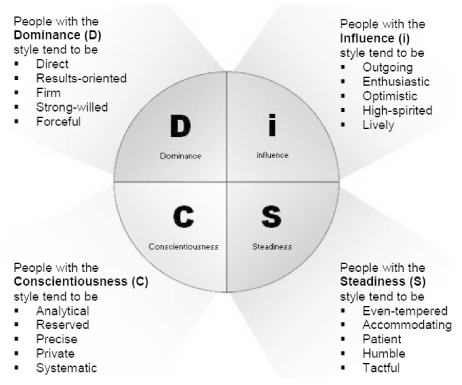J Korean Acad Nurs Adm.
2013 Jan;19(1):28-38.
DICS Behavior Pattern and Medication Errors by Nurses
- Affiliations
-
- 1Department of Nursing, Chungbuk National University, Cheongju, Korea.
- 2Cheongju St Mary's Hospital, Korea.
- 3Department of Nursing, Mokpo National University, Muan, Korea. miran@mokpo.ac.kr
Abstract
- PURPOSE
Human factor is one of the major causes of medication errors. The purpose of this study was to identify nurses' perception and experience of medication errors, examine the relationship of Dominance, Influence, Steadiness, Conscientiousness (DISC) behavior patterns and medication errors by nurses.
METHODS
A descriptive survey design with a convenience sampling was used. Data collection was done using self-report questionnaires answered by 308 nurses from one university hospital and two general hospitals.
RESULTS
The most frequent DISC behavioral style of nurses was influence style (41.9%), followed by steadiness style (23.7%), conscientiousness style (20.4%), and dominance style (14.0%). Differences in the perception and experience level of medication errors by nurses' behavioral pattern were not statistically significant. However, nurses with conscientiousness style had the lowest scores for in experience of medication errors and the highest scores for perception of medication errors.
CONCLUSION
The results of this study show that identification of the behavior pattern of nurses and application of this education program can prevent medication errors by nurses in hospitals.
Keyword
MeSH Terms
Figure
Reference
-
1. Armitage G, Knapman H. Adverse events in drug administration: A literature review. J Nurs Manag. 2003. 11:130–140. http://dx.doi.org/10.1046/j.1365-2834.2003.00359.x.2. Bang KH, Jang HK, Jung YM. Relation between the DISC behavior, coping type and level of stress and job satisfaction, organizational commitment of hospital employees. Korean J Hosp Manage. 2010. 15(3):17–32.3. Barker KN, Flynn EA, Pepper GA, Bates DW, Mikael RL. Medication errors observed in 36 health care facilities. Arch Intern Med. 2002. 162:1897–1903. http://dx.doi.org/10.1001/archinte.162.16.1897.4. Bradley A. Everything DISC Workplace profile: Assessment to Action. 2011. Retrieved September 26, 2012. from http://www.resourcesunlimited.com/everythingdisc/disc-everything-disc-workplace-profile.pdf.5. Etchells E, Juurlink D, Levinson W. Medication errors: The human factor. CMAJ. 2008. 178(1):63–64. http://dx.doi.org/10.1503/cmaj.071658.6. Faul F, Erdfelder E, Buchner A, Lang AG. Statistical power analyses using G*Power 3.1: Tests for correlation and regression analyses. Behav Res Methods. 2009. 41:1149–1160. http://www.glsworld.com/pdf/assessment-sample-reports/development-behavioral-style-insight.pdf.7. GLS Worldwide. Behavioral style insight report for Jane sample. 2011. 03. 17. Retrieved September 26, 2012. from http://www.glsworld.com/pdf/assessment-sample-reports/development-behavioral-style-insight.pdf.8. Hollnagel E. Human reliability analysis: Context and control. 1993. London: Academic Press.9. Inscape Publishing. Everything DISC Workplace profile. 2009. Retrieved September 26, 2012. from http://www.resourcesunlimited.com/everythingDISC/DISC-everything-DISC-workplace-profile.pdf.10. Jo KJ, Lee SH, Moon NS. Development of a unit-based program for clinical medication errors: LIFO. Hosp Line. 2004. 9(10):86–95.11. Kang JH. Study on the DISC pattern of constituent and the influence of revolutionary leadership that affects to job stress. 2007. Seoul, Korea: Kyung Hee University;Unpublished master's thesis.12. Khan FA, Hoda MQ. Drug related critical incidents. Anaesthesia. 2005. 60:48–52.13. Kim EK, Hwang JH, Kim CY, Oh BH. A study on nurse's perception and experience of medication error. Seoul J Nurs. 1998. 12(1):133–150.14. Kim EK, Jang HS, Kim MS, Hwang JI, Choi YK, Kim CK. Management of adverse event and medication safety for improvement of patient safety. 2006. Seoul: Quality Improvement Nurse Society.15. Kim JS. A study on the relationship between DISC behavior type and job satisfaction, organizational commitment, and organizational citizenship behavior. 2012. Gangneung, Korea: Kwandong University;Unpublished doctoral dissertation.16. Korea Educational Consulting Institute. DISC instructor process manual. 2002. Seoul: Author.17. Korea Educational Consulting Institute. PPS (personal profile system). 2004. Seoul: Author.18. Kwak YJ. The effects of supervisor-subordinate DISC behavioral tendencies on subordinates's organizational commitment and job satisfaction. 2012. Seoul, Korea: Sookmyung University;Unpublished master's thesis.19. Lee JA, Yoo IY. Teacher-efficacy and job stress according to DISC behavioral types in health teacher. J Korean Soc Living Environ Syst. 2011. 18(4):392–400.20. Lee HB. Understand DISK behavior style of doctor and patient. 2011. Retrieved September 26, 2012. from http://www.doctorstimes.com/news/articleView.html?idxno=148832.21. Lee KJ, Han HH, Choi YJ. A study on development program of knowledge information system about aviation human factor. 2011. Seoul: Korea Transportation Safety Authority.22. Lim WS. A study on health promotion behaviors and health conditions related to DISC behavior characteristics. 2009. Seoul, Korea: Kyung Hee University;Unpublished master's thesis.23. Lim WS. A study on health promotion behaviors and health conditions related to DISC behavior characteristics. 2009. Seoul, Korea: Kyung Hee University;Unpublished master's thesis.24. Marston WM. Emotion of normal people. 1979. Minneapolis: Persona Press.25. Nagel DC. Wiener EL, Nagel DC. Human error in aviation operations. Human factors in aviation (pp. 263-304). 1988. San Diego, CA: Academic Press.26. National Coordinating Council for Medication Error Reporting and Prevention. Council defines terms and sets goals for medication error reporting and prevention. 1995. 10. 16. Retrieved January 22, 2008. from http://www.nccmerp.org/press/press1995-10-16.html.27. Oh C, Yoon H. Perception and experience of medication errors in nurses with less than one year job experience. J Korean Acad Fundam Nurs. 2007. 14:6–17.28. Paradis AR, Stewart VT, Bayley KB, Brown A, Bennett AJ. Excess cost and length of stay associated with voluntary patient safety event reports in hospitals. Am J Med Qual. 2009. 24(1):53–60. http://dx.doi.org/10.1177/1062860608327610.29. Roh EK. Influence of job stress, DISC behavioral type and organizational social capital on job satisfaction among some nurses. 2011. Gwangju, Korea: Chosun University;Unpublished doctoral dissertation.30. Tam VC, Knowles SR, Cornish PL, Fine N, Marchesano R, Etchells EE. Frequency, type and clinical importance of medication history errors at admission to hospital: A systematic review. CMAJ. 2005. 173:510–515. http://dx.doi.org/10.1503/cmaj.045311.
- Full Text Links
- Actions
-
Cited
- CITED
-
- Close
- Share
- Similar articles
-
- Events related to medication errors and related factors involving nurses’ behavior to reduce medication errors in Japan: a Bayesian network modeling-based factor analysis and scenario analysis
- The influence of new nurses’ knowledge, nursing performance, and educational needs of chemotherapy medication on chemotherapy medication errors
- Perception and Experience of Medication Errors in Nurses with Less than One Year Job Experience
- Analysis of Medication Errors of Nurses by Patient Safety Accident Reports
- Mediating effect of grit on the influence of nurses’ silence behavior on medication safety competence: a cross-sectional study


